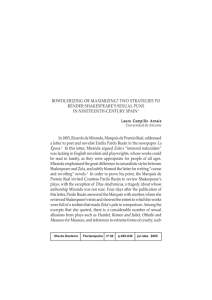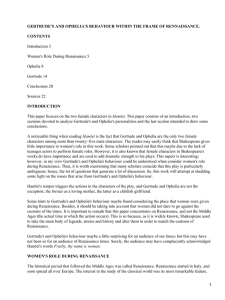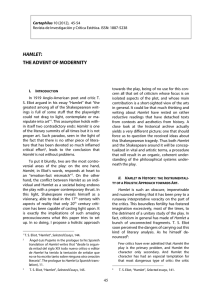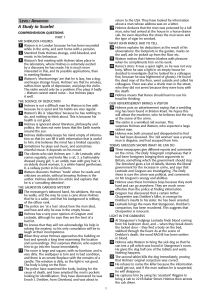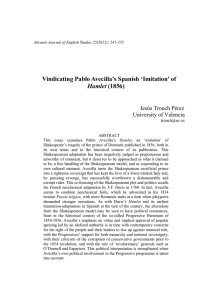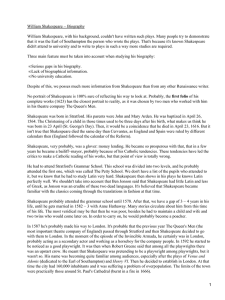SHAKESPEARE'S IMAGERY IN HAMLET imagery metaphor
Anuncio
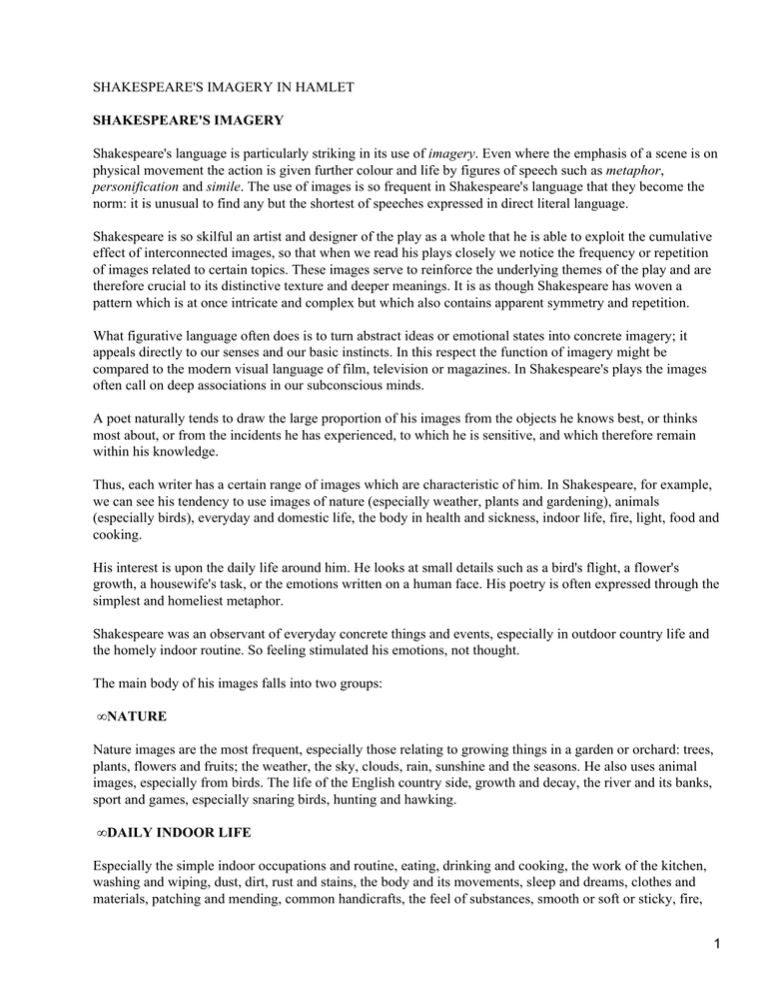
SHAKESPEARE'S IMAGERY IN HAMLET SHAKESPEARE'S IMAGERY Shakespeare's language is particularly striking in its use of imagery. Even where the emphasis of a scene is on physical movement the action is given further colour and life by figures of speech such as metaphor, personification and simile. The use of images is so frequent in Shakespeare's language that they become the norm: it is unusual to find any but the shortest of speeches expressed in direct literal language. Shakespeare is so skilful an artist and designer of the play as a whole that he is able to exploit the cumulative effect of interconnected images, so that when we read his plays closely we notice the frequency or repetition of images related to certain topics. These images serve to reinforce the underlying themes of the play and are therefore crucial to its distinctive texture and deeper meanings. It is as though Shakespeare has woven a pattern which is at once intricate and complex but which also contains apparent symmetry and repetition. What figurative language often does is to turn abstract ideas or emotional states into concrete imagery; it appeals directly to our senses and our basic instincts. In this respect the function of imagery might be compared to the modern visual language of film, television or magazines. In Shakespeare's plays the images often call on deep associations in our subconscious minds. A poet naturally tends to draw the large proportion of his images from the objects he knows best, or thinks most about, or from the incidents he has experienced, to which he is sensitive, and which therefore remain within his knowledge. Thus, each writer has a certain range of images which are characteristic of him. In Shakespeare, for example, we can see his tendency to use images of nature (especially weather, plants and gardening), animals (especially birds), everyday and domestic life, the body in health and sickness, indoor life, fire, light, food and cooking. His interest is upon the daily life around him. He looks at small details such as a bird's flight, a flower's growth, a housewife's task, or the emotions written on a human face. His poetry is often expressed through the simplest and homeliest metaphor. Shakespeare was an observant of everyday concrete things and events, especially in outdoor country life and the homely indoor routine. So feeling stimulated his emotions, not thought. The main body of his images falls into two groups: • NATURE Nature images are the most frequent, especially those relating to growing things in a garden or orchard: trees, plants, flowers and fruits; the weather, the sky, clouds, rain, sunshine and the seasons. He also uses animal images, especially from birds. The life of the English country side, growth and decay, the river and its banks, sport and games, especially snaring birds, hunting and hawking. • DAILY INDOOR LIFE Especially the simple indoor occupations and routine, eating, drinking and cooking, the work of the kitchen, washing and wiping, dust, dirt, rust and stains, the body and its movements, sleep and dreams, clothes and materials, patching and mending, common handicrafts, the feel of substances, smooth or soft or sticky, fire, 1 candles and lamps; sickness and medicine, parents and children, birth, death and marriage. SHAKESPEARE'S SENSES IN HAMLET HEARING We know about the sensitiveness of Shakespeare's ear, or of his real musical knowledge, both theoretical and technical. Ample evidence of this is to be found all through his plays, and his images from music are predominant and very familiar. He uses with particularly penetrating analogy the playing of a pipe and a viol, as in Hamlet's metaphor of the man easily swayed by emotion: ` That they are not a pipe for Fortune's finger To sound what stop she please.' [III.2.80], `Stop': finger−hole (and the note produced by `stopping' it. or his satirical conversation with Guildenstern about the recorder (`organ'): `And there is much music, ex" cellent voice, in this little organ. [III.2.375] Together with human voice, Shakespeare is interested or affected by the song of birds. He has many exquisite descriptions of their song and its emotional atmosphere. F.i. `the cock, that is the trumpet to the morn' [I.1.151]. `Trumpet' (trumpeter) SMELL Shakespeare has clearly a very acute sense of smell, and is peculiarly sensitive to bad smells. Perfume appears once as an image of great charm, when poor Ophelia returns Hamlet his gifts, which, she says, have lost `their perfume' [III.1.99] since he has proved unkind. `Perfume' (given by the words of so sweet breath composed) TOUCH Shakespeare is fond, as are most of the Elizabethan dramatists, of similes drawn from the texture of substances, flint, iron, steel, wax, sponge and so on. TASTE As regards taste, there is constant evidence, throughout the images, of Shakespeare's delicate and discriminating palate, especially when compared with his contemporaries and their stock images of banquets, surfeits, a sharpened appetite, the taste of honey and spice. Shakespeare betrays his appreciation of the value of flavouring and the necessity of seasoning. `There were no sallets (nothing piquant) in the lines to make the matter savoury [II.2.440], says Hamlet to the players, when describing −entirely in terms of food and taste− the speech he remembers having heard one of them make, and he impression it left on him and others. Just as with smell, his strongest feeling is reserved, not for sweet scents and fragrance, but for evil smells, which arouse in him a shudder of antipathy; so in this matter of taste, it is the loathsomeness of greasy, dirty, ill−cooked or ill−served food, and the intense feeling of repulsion which it arouses in him of which we are 2 more conscious than we are of his undoubted appreciation of what is delicate and good. SHAKESPEARE'S IMAGERY IN HAMLET 1.− OUTDOOR LIFE An interest in Shakespeare's imagery is the life of the country−side and its varying aspects: the winds, the weather and season, the sky and clouds, birds and animals. A) WEEDS AND FLOWERS All through his plays Shakespeare thinks of human life and action in the terms of a gardener. He thinks of matters human as growing plants and trees. He reflects that our bodies are gardens, and our wills the gardeners, so that whatever is planted or sown in our own natures entirely depends on the power and authority of our wills. He is particularly interested in the processes of growth and decay. He is impressed, as all the gardeners must be, by the vitality and strength of seeds, especially of weeds, and he is continually conscious of a similar strength and power in the weeds and faults in human character. He sees the diseases in plants −especially canker in roses− with the gardener's eye, and resents their destruction of beauty. In his imagination the disease is continually affecting and damaging the plant exactly as evil passions or repressions destroy the human being. From the very beginning of the play the image of the weed is present as the Ghost uses the image of the weed to incite Hamlet to revenge: And duller shouldst thou be than the fat weed That roots itself in ease on Lethe Wharf Wouldst thou not stir in this [I.5.32] The Ghost tells Hamlet that if he does not take revenge on Claudius, Hamlet will be duller (more stupid, more lacking in feeling) than the disgusting weed that grows on the banks of the river of forgetfulness. Lethe is a river of Hades: according to the classical poets, it caused oblivion in those who drank it. The word warf is used because the spirits were supposed to embark on Charon's boat in order to cross the river. As the fat weed Shakespeare may have had in mind asphodel, which grew in the fields of Hades. The weed is the symbol of corruption in Denmark and it is associated with poison and disease. The rightful king has been poisoned and now the whole country is being poisoned, contaminated by the mildew'd ear. An evil king is ruling Denmark and therefore corruption is growing. The world is an unweeded garden and Hamlet asks his mother: And do not spread the compost of the weeds To make them ranker In his first soliloquy, Hamlet says of the world, Tis an unweeded garden 3 That grows to seed; things rank and gross in nature Possess it merely [I.2.134] A little later in the speech, it becomes clear that Hamlet's disgust at the world arises from his disgust at the fact that his mother is now sleeping with his uncle. A violet in the youth of primy nature [I.3.7.] This, says Laertes, is how Ophelia should think of Hamlet's feelings for her. Laertes is willing to concede that Hamlet may be sincere, but his favor is like the violet − quick to bloom, quick to die, characterising him as forwards, not permanent, sweet, not lasting. Violets, the symbol of faithfulness explicity represent Prince Hamlet. They are also a symbol of humility. The canker galls the infants of the spring Too oft before their buttons be disclosed [I.3.39] Says Laertes to his Ophelia, as he is warning her away from her relationship with Hamlet. The canker is a worm, and to gall is to break the skin. Infants of the spring is metaphorical for early spring flowers, and their buttons are their unopened buds. Putting all together what Laertes is saying is something like this: Ophelia could be ruined by the worm of temptation, which would hollow out her heart before it broke the surface: This is an image of a disease working its way from inside to outside. Tis given out that, sleeping in my orchard A serpent stung me [I.5.35] Says the Ghost to Hamlet. An orchard would have fruit trees in it, but the word orchard also means garden. Thus we have a scene that echoes events in the garden of Eden: As the serpent seduced Eve and brought death to Adam, so Claudius seduces Gertrude and brings death to king Hamlet. B) RIVER Another of the chief interests of Shakespeare's mind was the river. As regards river sports we find a fishing image in Hamlet, when he alludes to the wary nature of the carp, Your bait of falsehood takes this carp of truth [II.1.63] C) HUNTING Next to the river, the most constant outdoor background in Shakespeare's mind is hunting of various kinds. He liked watching the dogs almost as much as watching the deer, and knew all about their skill and shortcomings. How cheerfully on the false trail they cry! O, this is counter you false Danish dogs! [IV.5.111] Gertrude, with unusual bitterness of language, imagines the intruders as a pack of baying hounds pursuing a false scent (false because the king is not guilty of Polonius's murder) 4 Counter means hunting the trail backwards. You false Danish dogs! : Presumably Shakespeare took it for granted that the queen−consort of the monarch was a foreigner. D) BIRDS A boyhood sport, which has made a profound impression on Shakespeare, is the trapping and snaring of birds. His bird images are remarkable for the intense feeling and sympathy they reveal for the trapped, limed or snared bird, which to him symbolises the greatest pitch of terror and agony mortal creature may endure. So Claudius, at his prayers, realising that he is so hopelessly besmirched and involved in the results of his crime, that he dare not even pray for forgiveness, cries: O, wretched state! O, bosom black as death! O limed soul, that struggling to be free Art more engaged! [III.3.67] Limed soul ( the soul is like a bird that has been caught by the laying of `lime', a glue−like substance) Shakespeare's attitude in his images, is unique among the dramatists of his time, for he shows a sympathy with an understanding of the animal's point of view and sufferings which no one in his age approaches. E) BOWLS Of all the games Shakespeare mentions, bowls was the one he himself played and liked best. In Hamlet we can find images from bowls, such as: `Ay, there's the rub' [III.1.65] Rub ( obstacle, in the game of bowls) 2.− INDOOR LIFE Shakespeare's images from indoor life which are very numerous, reflect in the most marked and interesting way of life and activities in a simple or a farm−house kitchen, where we would surmise, when indoors, he spent a good part of his boyhood. Nothing there has passed unobserved, and some things which entail unpleasantness, especially to the sense of smell, are very vividly remembered. Shakespeare has a usually large number of images drawn from the daily work and occupations of women in a kitchen and living room. Various objects to be found in a kitchen are a favourite source of imagery. For instance, when Gertrude without naming any object at all, so accurately describes the unfortunate result we have all experienced when trying with the utmost care to carry an overfull jug or bowl: `So full of artless jealousy is guilt It spills itself in fearing to be spilt. [IV.5.19] Artless jealousy (uncontrolled suspicion) Spills (reveals and destroys) 5 Some of Shakespeare's images of cooking or the preparing of food are extraordinarily apt and vivid, and leave us with an unforgettable picture. Horatio's report on the appearance of the soldiers of the watch when they saw the Ghost: `distill'd Almost to jelly with the act of fear' [I.2.205] Shakespeare shows a knowledge of numbers of trades or crafts and their processes. For instance, we find carpetering images. The hooping of a barrel with bands of metal is one of his favourite images and serves him to express vividly various ideas of binding, strengthening and embracing. Such are pictures of two people being held firmly together in the well−known advice of Polonius with regard to tried friends: `Grapple them to thy soul with hoops of steel' [I.3.63] One of the best known philosophical reflections of Shakespeare is in the form of a rough carpetering simile, used with close exactitude and knowledge of the subject. This is Hamlet's remark to Horatio that: `There's a divinity that shapes our ends, Rough−hew them how we will' [V.2.10] Which we know applies specifically to the cutting and shaping of wool−skewers, which Shakespeare, in view of his father's trade, knew all about. Rough−hew (like a piece of timber) This is the first evidence of Hamlet's new piety or Christian patience. Perhaps Shakespeare is interesting the audience by showing a new kind of irresponsibility in Hamlet. SICKNESS AND DISEASE The number of sickness images in Hamlet is greater than in any other play. There is a crushing presence of images related to Hamlet's sickness and how the idea of an ulcer or tumour expressed the moral corruption of the Danish Court. In Hamlet we are almost startled at the constant conception of a corrupt and hidden tumour or cancer, which is the central imaginative symbol of the tragedy. We find in these `sickness' images a feeling of horror, disgust and even helplessness. The general sense of inward and unseen corruption, of the man helplessly succumbing to a deadly and `foul disease' [IV.1.21], which feeds `even on the pith of life' is very strong. This is accompanied by the impression that for such a terrible ill the remedy must be drastic,for `diseases desperate grown By desperate appliance are relieved, Or not at all,' [IV.3.9] (a proverbial idiom, which occurs in the form `A desperate disease must have a desperate cure) and that anything short of this is but to 6 `skin and film the ulcerous place Whiles rank corruption, mining all within Infects unseen.' [III.4.147] This is the general symbolic trend of these images in the play, and Hamlet and the others pay the price demanded for the necessary cleansing of the `foul body of the infected world' Shakespeare succeeds in creating an atmosphere of cold and desolated darkness, in the face of which, men feel `sick at hart' [I.1.9] . This is the first image of corruption and sickness, introduced before we are aware of the origin of this decadence. Hamlet is convinced of the necessity of killing Claudius, whom he describes as a cancer in society. And he has to success in his duty in removing that cancer. Here we have some other disease's images: − The first act, with the exception of the third scene, prepares us for the revelation that is going to set off the tragedy. That is the revelation of the Ghost of the killed king, who appears at first in silence before the guards and Horatio. Horatio interprets the spectre as a sign of the dangers that face the State, as an illusion of his senses and a soul coming from purgatory to complete some unfinished task. − The moon `was sick almost to doomsday with eclipse' [I.1.120] says Horatio, as he describes the conditions in Rome just before the murder of Julius Caesar. He believes that the appearance of the Ghost is a portent to Denmark, as the sick moon was to Rome. `The canker galls the infants of the spring Too oft before their buttons be disclosed' [I.3.39] The `canker' or worm is Ophelia's love for Hamlet. Since Hamlet cannot marry Ophelia , he can only break her heart. Then she would be like the flower which has been eaten by a canker, hollowing out her heart. This image of a disease working its way from inside to outside will be repeated when the Ghost describes how Claudius's poison worked within his body. − The aversion against sexuality and the attack against women which characterises Hamlet's discourse, have their origins in the hurried second marriage of his mother, in a time in which, according to the Bible, the marriage between a woman and her husband's brother was considered incestuous. It is the marriage between his mother and Claudius and not his father's assassination what provokes in Hamlet violent words full of images of corruption and disease. Hamlet speaks of his mother's sin as a blister on the `fair forehead of an innocent love' [III.4.43], he speaks of her `sick soul' [IV.5.17], and the emotion is so strong and the picture so vivid, that the metaphor overflows into the verbs and adjectives: heaven's face, he tells her is `thought−sick' [III.4.51] at the act; her husband is a mildew'd ear, blasting his wholesome brother [III.4.64] ; to have married him, her sense must be not only `sickly' but `apoplex'd' [III.4.73,80]. Finally, at the end of that terrific scene [III.4], he implores her not to soothe herself with the belief that his father's apparition is due to her son's madness, and not to her own guilty, for that `will but skin and film the ulcerous place, 7 Whiles rank corruption, mining all within, Infects unseen´ [III.4.147] So also, later he compares the unnecessary fighting between Norway and Poland to a kind of tumour which grows out of too much prosperity. [IV.4.27] He sees the country and the people in it alike in terms of a sick body needing medicine or the surgeon's knife. When he surprises Claudius at his prayers, he exclaims: `This physic but prolongs thy sickly days' [III.3.96] and he describes the action of conscience in the `unforgettable picture of the healthy, ruddy countenance turning pale' [III.1.84] with sickness. A mote in the eye, a vicious mole, a galled chilblain, a probed wound and purgation, are also among Hamlet's images; and the mind of Claudius runs equally on the same theme. When he hears of the murder of Polonius, he declares that his weakness in not sooner having had Hamlet shut up was comparable to the cowardly action of a man with a `foul disease' who `To keep it from divulging, let it feed Even on the pith of life' [IV.1.21] and later, when arranging to send Hamlet to England and to his death, he justifies it by the proverbial tag: `diseases desperate grown By desperate appliance are relieved, Or not at all' [IV.3.9] And adjures the English king to carry but his behest, in the words of a fever patient seeking a sedative: `For like the hectic in my blood he rages, And thou must cure me. [IV.3.68] When working on Laertes, so that he will easily fall in with the design for the fencing match, his speech is full of the same underlying thought of a body sick, or ill at ease: `goodness, growing to a plurisy, Dies in his own too much' [IV.7.118] And finally, he sums up the essence of the position and its urgency with lightning vividness in a short medical phrase `But, to the quick o' the ulcer: 8 Hamlet comes back.' [IV.7.124] In Hamlet, the dominating thought is rottenness, disease, corruption, the result of dirt; the people are `muddied', `Thick and unwholesome in their thoughts and whispers' [IV.5.82] and this corruption is, in the words of Claudius, `rank' and `smells to heaven', so that the state of things in Denmark which shocks, paralyses and finally overwhelms Hamlet, is as the foul tumour breaking inwardly and poisoning the whole body, while showing `no cause without Why the man dies' [IV.4.28] This image pictures and reflects not only the outward condition which causes Hamlet's spiritual illness, but also his own state. Indeed, the shock of the discovery of his father's murder and the sight of his mother's conduct have been such that when the play opens Hamlet has already begun to die, to die internally; because all the springs of life − love, laughter, joy, hope, belief in others− are becoming frozen at their source, are being gradually infected by the disease of the spirit which is −unknown to him− killing him. To Shakespeare's pictorial imagination, therefore, the problem in Hamlet is not predominantly that of will and reason, of a mind too philosophic or a nature temperamentally unfitted to act quickly; he sees it pictorially no as the problem of an individual at all, but as something greater and even more mysterious, as a condition for which the individual himself is apparently not responsible, any more than the sick man is to blame for the infection which strikes and devours him, but which, nevertheless, in its course and development, impartially and relentlessly, annihilates him and others, innocent and guilty alike. But in the play we can see how the ugliness of the dominating image, that of disease and ulcer, is counteracted, and the whole lighted up by flashes of sheer beauty in the imagery. Thus, the tragic atmosphere of physical sickness and revolting disease, is illumined by the glow of his description of his father's portrait, the associations of beauty called up by Hyperion, Jove and Mars, or the exquisite picture evoked by the contemplation of the grace of his father's poise: `like the herald Mercury New−lighted on a heaven−kissing hill' [III.4.59] These beauties are specially noticeable in the many personifications, as when, with Horatio, we see `the morn, in russet mantle clad' as she `walks o'er the dew of yon high eastward hill' [I.1.167], or, with Hamlet, watch Laertes leaping into Ophelia's grave and ask: `whose phrase of sorrow Conjures the wandering stars and makes them stand Like wonder−wounded hearers? [V.1.251] 9 Peace, with her wheaten garland, Niobe all tears, Ophelia's garments `heavy with their drink', which pull her from her `melodious lay' to muddy death, or the magnificent picture of the two sides of the queen's nature at war, as seen by the elder Hamlet: `But look, amazement of thy mother sits: O, step between her and her fighting soul; These, and many more, are the unforgettable and radiant touches of beauty in a play which has, as images, much that is sombre and unpleasant. BIBLIOGRAPHY − A.C. Bradley, Shakespearean Tragedy, Penguin, 1991 • Spurgeon, Caroline, Shakespeare's imagery and what it tells us, Cambridge University Press, 1996. • Donawerth, Jane, Shakespeare and the Sixteenth−Century Study of Language, USA, 1984 • Drama and Philosophy, Themes in Drama 12, Cambridge University Press. • Encuentros con Shakespeare, (UNED), Madrid, 1985. • Shakespeare, William, Hamlet, Penguin, England, 1996. • Othello, Longman Literature Shakespeare. Ed. Robert Southwick. − I have also taken information from internet, specially several examples of passages of different images. FORTUNE, FATE, AND PROVIDENCE • Horatio cries out to the Ghost, `If thou art privy to this country's fate Which, happily, foreknowing may avoid O, speak!' [I.1.133] This suggests that fate isn't inevitable. A little earlier, however, Horatio seems almost certain that the appearance of the Ghost is a terrible portent, similar to that time in Rome, just before "the mightiest Julius fell," when "The graves stood tenantless and the sheeted dead Did squeak and gibber in the Roman streets" [I.1.115] In any case, Horatio conceives of "fate" as a disaster that threatens a whole country. • In the course of commenting about how just one fault can ruin a man's reputation, Hamlet says that the fault can be "nature's livery, or fortune's star" [I.4.32]. In other words, the man can either be born with the fault or pick it up later. Hamlet's thinking seems to be that the fault is something that happens 10 to the man, rather than something that he deliberately chooses. A little later in the same scene, when his friends are trying to keep him from following the Ghost, because the Ghost may be an evil spirit, Hamlet exclaims, "My fate cries out, And makes each petty artery in this body As hardy as the Nemean lion's nerve" [I.4.81] He is saying that it is his fate to follow the Ghost, and that gives him great courage. • Hamlet asks Rosencrantz and Guildenstern how they are doing, and Guildenstern answers, "Happy, in that we are not over−happy, on fortune's cap we are not the very button" [II.2.228] Of course, the button is at the top of the cap. Hamlet then guesses that they not the soles on Fortune's shoes, either, and this leads to Guildenstern's joke that he and Rosencrantz live in Fortune's "privates." Hamlet responds, "O, most true; she is a strumpet" [II.2.235] None of this banter is very funny or very original. It was a common idea of the time that Fortune is a whore; she's always likely to screw you over. Later in the same scene, the idea that Fortune is a whore comes up again, but not as a joke. First Player is reciting a piece that Hamlet has requested, about the death of "old grandsire Priam" at the hands of "hellish Pyrrhus." After First Player has described the merciless killing, he comments: Out, out, thou strumpet, Fortune! All you gods, In general synod take away her power; Break all the spokes and fellies from her wheel, And bowl the round nave down the hill of heaven, As low as to the fiends! [II.2.493] He's asking the gods to break up Fortune's wheel and roll its hub ("nave") down to hell. In pictures of Fortune and her wheel, the wheel is upright, and Lady Fortune stands beside it, keeping it spinning. People, often with asses' ears, are trying to jump on to the wheel, so that they will rise up, but those on the top of the wheel are about to be thrown off the other side. The idea is that our destinies are merely random, and we are fools to thinks otherwise. The First Player's speech asks the gods to change all that, so that the world will be ruled by justice, not chance. HAMLET'S "MADNESS" Pleading with Hamlet not to follow the Ghost, Horatio asks him to think about what might happen if the Ghost "assume some other horrible form, / Which might deprive your sovereignty of reason / And draw you into madness" (1.4.72−74) Horatio believes that the Ghost is not Hamlet's father in the form of a ghost, but a spirit in the form of Hamlet's father. That spirit could instantly take on another shape or lure Hamlet to the edge of a cliff, where the sight of the depth "so many fathoms to the sea" puts "toys of desperation . . . into every brain." "I could a tale unfold whose lightest word / Would harrow up thy soul" (1.5.15−16). The Ghost is telling Hamlet why he cannot reveal the secrets of his "prison−house"−−purgatory. It is implied that the story of the 11 Ghost's punishments would drive mere humans mad. "These are but wild and whirling words, my lord" (1.5.133), says Horatio when Hamlet appears about to tell him what the Ghost said, but suddenly changes course. "I perchance hereafter shall think meet / To put an antic disposition on" (1.5.171−172), Hamlet warns Horatio and Marcellus. In the course of swearing them to secrecy about the Ghost, Hamlet adds that they can't so much as hint that they know anything, even if he should act "strange or odd." Hamlet never says why he might act strange, but pretended madness was a widely−used plot device in the revenge tragedy of Shakespeare's time. In those plays, the revenger acted crazy so that his targets wouldn't know what he was up to until the minute before he killed them. Shakespeare wrote such a tragedy; its name is Titus Andronicus. "Mad for thy love?" (2.1.82), Polonius asks Ophelia, when she tells him about Hamlet's strange visit to her closet. It isn't really a question, because Polonius jumps to his conclusion and then sticks with it. For the rest of the play he is sure that Hamlet has been driven over the edge because Ophelia (on her father's orders) won't see him anymore. Polonius' idea has its roots in a popular idea of the time, which was that frustrated love brings on a melancholy that is a near neighbour to madness. Compare Ophelia's description of Hamlet with Benvolio's description of Romeo, in the first scene of Romeo and Juliet, when Romeo was in love with the never−seen Rosaline. Romeo, too, was melancholy, and sighed, and generally acted strange. "Something have you heard / Of Hamlet's transformation" (2.2.3−4). The King, when he is telling Rosencrantz and Guildenstern to find out what's wrong with Hamlet, says that Hamlet has been "put . . . from th'understanding of himself." The King may be just saying this as an excuse to see what he can find out what Hamlet may know about his father's murder, but Gertrude describes Hamlet as "My too much changed son" (2.2.36), and she probably has Hamlet's best interests at heart. Polonius says to the King and Queen, "your noble son is mad: / Mad call I it; for, to define true madness, / What is't but to be nothing else but mad? (2.2.92−94). Thus begins Polonius' windy explanation of Hamlet's madness, which Polonius attributes to disappointed love for Ophelia. "Though this be madness, yet there is method in't" (2.2.205−206), says Polonius to himself as he is in the midst seeing for himself just how crazy the prince really is. "I have of late−−but wherefore I know not−−lost all my mirth" (2.2.295−296), says Hamlet to Rosencrantz and Guildenstern. After discovering that they are spying on him, he says he'll tell them what's wrong with him, to save them the trouble of finding out for themselves. Because of this, it's hard to tell how to take the famous speech. When he says "man delights not me" (2.2.308−309) is he sincere, or is he playing the melancholy Dane for the benefit of his false friends? "I am but mad north−north−west: when the wind is southerly I know a hawk from a handsaw" (2.2.378−379), says Hamlet to Rosencrantz and Guildenstern at the conclusion of their attempt to find out what's wrong with him. THIS IS THE END, BEAUTIFUL FRIEND... THIS IS THE END, MY ONLY FRIEND, THE END.............. 12
